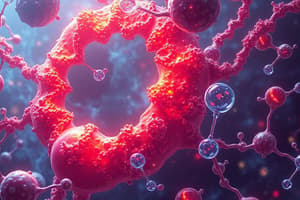Podcast
Questions and Answers
The monomers that make up proteins are called which of the following?
The monomers that make up proteins are called which of the following?
- Nucleotides
- Carbohydrates
- Fatty acids
- Amino acids (correct)
Lipids are not polymers because _____
Lipids are not polymers because _____
They are not made of monomers bonded together by dehydration reactions
Noncovalent bonds are which of the following?
Noncovalent bonds are which of the following?
Weak bonds such as hydrogen bonds
How can two proteins, like hemoglobin and antibodies, do such different things despite being proteins?
How can two proteins, like hemoglobin and antibodies, do such different things despite being proteins?
Which of the following is not a carbohydrate?
Which of the following is not a carbohydrate?
Which of the following is the name of the type of monomers that make up polysaccharides?
Which of the following is the name of the type of monomers that make up polysaccharides?
The composition of phospholipids includes which of the following?
The composition of phospholipids includes which of the following?
The functional properties of DNA are due to which of the following?
The functional properties of DNA are due to which of the following?
What forces drive DNA to form a double helix shape?
What forces drive DNA to form a double helix shape?
What is the type of reaction called that converts glycogen to glucose?
What is the type of reaction called that converts glycogen to glucose?
Which of the following is a carbohydrate with structural function?
Which of the following is a carbohydrate with structural function?
Flashcards are hidden until you start studying
Study Notes
Proteins
- Proteins are composed of monomers called amino acids.
- Hemoglobins transport oxygen (O2) to cells; antibodies play a crucial role in the immune system.
- The diverse functions of proteins, such as hemoglobins and antibodies, arise from their unique three-dimensional structures.
Lipids
- Lipids, unlike polymers, are not made of repeating monomers connected by dehydration reactions.
- Phospholipids consist of fatty acids and glycerol, essential components of cell membranes.
Carbohydrates
- Polysaccharides are formed from monomers known as sugars.
- Chitin is a carbohydrate with structural functions, contributing to the integrity of cellular structures.
DNA
- The functional properties of DNA are derived from its structural characteristics.
- DNA forms a double helix due to noncovalent bonds between bases, while the sugar-phosphate backbone interacts with water.
Energy Storage
- The human body stores energy as glycogen, a polymer of glucose.
- When energy is needed, glycogen undergoes hydrolysis to convert back to glucose.
Studying That Suits You
Use AI to generate personalized quizzes and flashcards to suit your learning preferences.



